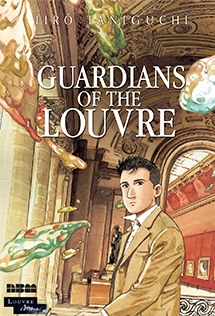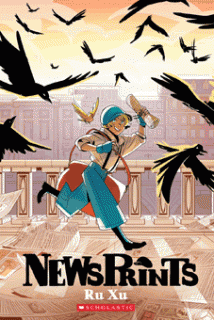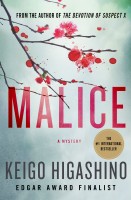My News and Reviews
In a few more days and March will be here and in a few more days the winner of the Tokyo ESP manga giveaway will be announced. Never fear though, there’s still a little time left to enter for a chance to win the first omnibus in the series! Simply tell me a little about a favorite psychic/esper from a manga. (A quick note: Normally I announce giveaway winners on Wednesday mornings but, because I have an all-day job interview on the 1st, this time the announcement will likely be made sometime on Wednesday evening instead.)
As for some interesting things I came across last week: The National Museum of Modern Art in Tokyo has created an online archive of early Japanese animation. An English-language version of the site is currently in the works, but even if you can’t read Japanese if you click around enough you’ll find the some of the videos available for viewing. The University of Michigan’s Center for Japanese Studies recently hosted two master rakugo artists–Yanagiya Sankyo and Yanagiya Kyonosuke–and has posted a video of one of their events. The video includes a brief introduction to rakugo, a demonstration and performance, and a question and answer session.
There are also a few podcasts worth mentioning (though I haven’t actually had the opportunity to listen to most of them yet): The most recent episode of Comic Books Are Burning in Hell is devoted to the late Jiro Taniguchi. Tofugu started a podcast not too long ago and recently talked with Alexander O. Smith about What Makes a Good Japanese Translator? (Smith does a fair amount of video game translation but translates novels and manga as well. He’s also one of the founders of Bento Books.) Vertical Comics recently started a podcast, too, and the first episode of the Mangocast is now available for listening.
As for crowdfunding efforts for queer comics, the end of February has seen quite a few Kickstarter projects launch: The Husband & Husband campaign is hoping to publish the first volume of the cute and funny webcomic in print. The Dates anthology, which focuses on queer historical fiction, is back for a second volume. (Though I haven’t written a quick take for it yet, I have the first volume and it’s great.) The Go Get a Roomie! project is raising funds to print the second volume and reprint the first volume of the webcomic. And finally, Digital Manga’s most recent Kickstarter has launched–Juné Manga is working with Velvet Toucher, a Japanese artist living in the United States, to release Eden’s Mercy.
Quick Takes
 Guardians of the Louvre by Jiro Taniguchi. I’ve read most but not quite all of Taniguchi’s manga that has been released in English, but his recent passing reminded me that I hadn’t yet read Guardians of the Louvre, the latest one to have been released. One of the most remarkable things about Guardians of the Louvre is its full-color artwork. The volume is actually part of the “Louvre Collection,” a series of comics commissioned by the Louvre that feature the museum and its collections. (Hirohiko Araki’s Rohan at the Louvre is part of the same series.) Taniguchi is an extremely versatile creator; while some of his manga are action-packed, others are more introspective. Guardians of the Louvre is definitely one of the latter. The story is a quiet and contemplative exploration of art and inspiration, following a manga creator who is visiting Paris on his own for a few days. He falls ill soon after he arrives but pushes through in order to visit the Louvre. And so when he seems to start slipping through time, meeting artists and historical figures associated with the museum, not to mention the embodiments of some of the works housed there, he’s never quite sure how much of his visit is based in reality and how much is a fever dream.
Guardians of the Louvre by Jiro Taniguchi. I’ve read most but not quite all of Taniguchi’s manga that has been released in English, but his recent passing reminded me that I hadn’t yet read Guardians of the Louvre, the latest one to have been released. One of the most remarkable things about Guardians of the Louvre is its full-color artwork. The volume is actually part of the “Louvre Collection,” a series of comics commissioned by the Louvre that feature the museum and its collections. (Hirohiko Araki’s Rohan at the Louvre is part of the same series.) Taniguchi is an extremely versatile creator; while some of his manga are action-packed, others are more introspective. Guardians of the Louvre is definitely one of the latter. The story is a quiet and contemplative exploration of art and inspiration, following a manga creator who is visiting Paris on his own for a few days. He falls ill soon after he arrives but pushes through in order to visit the Louvre. And so when he seems to start slipping through time, meeting artists and historical figures associated with the museum, not to mention the embodiments of some of the works housed there, he’s never quite sure how much of his visit is based in reality and how much is a fever dream.
 He’s My Only Vampire, Volumes 1-3 by Aya Shouoto. While I don’t actively avoid vampire manga, I also don’t actively seek it out. Usually there has to be something a little “extra” to catch my attention. In the case of He’s My Only Vampire, I had decided to seek out more of Shouoto’s work available in English while waiting for more of The Demon Prince of Momochi House to be released. He’s My Only Vampire is kind of an odd series and at this point the manga doesn’t seem to have a clear direction. It’s as if Shouoto is either trying to do too much at once with the story or hasn’t quite decided where it should go yet. It can still be pretty entertaining from time to time, though. Shouoto’s artwork, even though anatomy seems to occasionally go out the window, can be lovely and sensual, too. So far the best part of the manga is the three main characters–Kana, the strong and spunky heroine, Aki, the titular vampire and Kana’s long-lost childhood friend, and Jin, a high-school delinquent who has recently discovered that he is at least part werewolf. Personality-wise and the relationship-wise they’re all sort of goofy and their interactions can be quite amusing. The story is taking some darker turns, but I think I prefer its humor.
He’s My Only Vampire, Volumes 1-3 by Aya Shouoto. While I don’t actively avoid vampire manga, I also don’t actively seek it out. Usually there has to be something a little “extra” to catch my attention. In the case of He’s My Only Vampire, I had decided to seek out more of Shouoto’s work available in English while waiting for more of The Demon Prince of Momochi House to be released. He’s My Only Vampire is kind of an odd series and at this point the manga doesn’t seem to have a clear direction. It’s as if Shouoto is either trying to do too much at once with the story or hasn’t quite decided where it should go yet. It can still be pretty entertaining from time to time, though. Shouoto’s artwork, even though anatomy seems to occasionally go out the window, can be lovely and sensual, too. So far the best part of the manga is the three main characters–Kana, the strong and spunky heroine, Aki, the titular vampire and Kana’s long-lost childhood friend, and Jin, a high-school delinquent who has recently discovered that he is at least part werewolf. Personality-wise and the relationship-wise they’re all sort of goofy and their interactions can be quite amusing. The story is taking some darker turns, but I think I prefer its humor.
 Magi: The Labyrinth of Magic, Volumes 1-4 by Shinobu Ohtaka. I know quite a few people who love Magi and have heard plenty of great things about the series but despite those facts it’s still taken me this long to finally get around to reading the manga. Magi more or less starts out as a dungeon crawl which, while highly entertaining, isn’t exactly the most compelling narrative for a series that’s already over thirty volumes and still ongoing. But after the first dungeon crawl (and I suspect that there will likely be more of those in the future) Ohtaka begins delving into the characters and their motivations while exploring the vast world in which the live. In part Magi is inspired by One Thousand and One Nights but Ohtaka does not strictly adhere to those stories and characters, instead creating a complex world that is reminiscent of but distinct from that work. Magi really is a great series, with plenty of magic, mystery, and adventure; I can easily understand why it’s so well-loved. The artwork is clear and attractive, the settings and characters are interesting and well-realized, and the story, worldbuilding, and action are engaging. I also particularly appreciate that the women can be just as badass as the men in the series and in some cases are even more so.
Magi: The Labyrinth of Magic, Volumes 1-4 by Shinobu Ohtaka. I know quite a few people who love Magi and have heard plenty of great things about the series but despite those facts it’s still taken me this long to finally get around to reading the manga. Magi more or less starts out as a dungeon crawl which, while highly entertaining, isn’t exactly the most compelling narrative for a series that’s already over thirty volumes and still ongoing. But after the first dungeon crawl (and I suspect that there will likely be more of those in the future) Ohtaka begins delving into the characters and their motivations while exploring the vast world in which the live. In part Magi is inspired by One Thousand and One Nights but Ohtaka does not strictly adhere to those stories and characters, instead creating a complex world that is reminiscent of but distinct from that work. Magi really is a great series, with plenty of magic, mystery, and adventure; I can easily understand why it’s so well-loved. The artwork is clear and attractive, the settings and characters are interesting and well-realized, and the story, worldbuilding, and action are engaging. I also particularly appreciate that the women can be just as badass as the men in the series and in some cases are even more so.
 NewsPrints by Ru Xu. My introduction to Xu’s work was through the beautifully illustrated webcomic Saint for Rent. However, NewsPrints is her debut graphic novel. Published by Scholastic the comic is aimed towards middle grade readers but it can be appreciated by older readers, too. NewsPrints, while still being very approachable, actually tackles some pretty weighty subject matter–war, propaganda, identity, and so on. The comic is about Blue, an orphan who is hiding the fact that she is a girl so that she can work as a newsboy for the Bugle, one of the only newspapers that actually reports the truth. The Bugle has taken in and cares for other orphans as well, but Blue is afraid that she won’t be able to hide her secret much longer and may lose her newfound family because of it. The city she lives in has very firmly entrenched ideas about what is and is not appropriate for girls to do. Blue is embroiled in an extremely dangerous situation when she meets and becomes friends with Crow who is also hiding a secret, one that could greatly influence the course of the war. Though NewsPrints tells a complete story the ending is left fairly open. Apparently a sequel is currently in the works; I’m very curious to see where Xu takes the comic next.
NewsPrints by Ru Xu. My introduction to Xu’s work was through the beautifully illustrated webcomic Saint for Rent. However, NewsPrints is her debut graphic novel. Published by Scholastic the comic is aimed towards middle grade readers but it can be appreciated by older readers, too. NewsPrints, while still being very approachable, actually tackles some pretty weighty subject matter–war, propaganda, identity, and so on. The comic is about Blue, an orphan who is hiding the fact that she is a girl so that she can work as a newsboy for the Bugle, one of the only newspapers that actually reports the truth. The Bugle has taken in and cares for other orphans as well, but Blue is afraid that she won’t be able to hide her secret much longer and may lose her newfound family because of it. The city she lives in has very firmly entrenched ideas about what is and is not appropriate for girls to do. Blue is embroiled in an extremely dangerous situation when she meets and becomes friends with Crow who is also hiding a secret, one that could greatly influence the course of the war. Though NewsPrints tells a complete story the ending is left fairly open. Apparently a sequel is currently in the works; I’m very curious to see where Xu takes the comic next.







